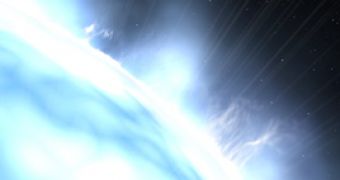Most stars in the universe, including our Sun, end their lives as white dwarfs, highly dense objects burning the leftovers of the nuclear fuel of what used to be the core of the star during most of its life. These objects can be so dense that they can pack a mass of about 1.5 times that of the Sun into a volume comparable to that of our planet. Pulsating white dwarfs, one class of such stars, have been first discovered more than two decades ago and until now they contained two types of stellar objects.
These were white dwarfs with hydrogen outer layers, making about 80 percent of the white dwarf population, and white dwarfs with helium outer layers, representing for the remaining 20 percent. Now, with the help of the Otto Struve Telescope at McDonald Observatory astronomers Michael H. Montgomery and Kurtis A. Williams in collaboration with graduate student Steven DeGennaro from the University of Texas have predicted and confirmed the existence of a third type of pulsating white dwarfs, those having a carbon outer layer.
In fact, rather similar objects have been discovered last year by Patrick Dufour and James Liebert from the University of Arizona and were called 'hot carbon white dwarfs', stars that had somehow ejected both the hydrogen and the helium outer layers leaving behind only a carbon shell. Due to this peculiar configuration, it was then predicted that such white dwarfs could be the remnants of stars too lightweight to explode in supernovae and may be amongst the heaviest of their kind.
Soon after the announcement made by the Arizona team, Montgomery showed that it was possible that these stars could pulsate, varying their light intensity in the process. He reckoned that by applying a study technique called 'asteroseismology', astronomers should be able to study some of the features of the interiors of such stars. Thus, the search for a pulsating carbon white dwarf began. With the help of the Struve Telescope, DeGennaro discovered a possible object about 800 light years away in the Ursa Major constellation, varying its intensity by two percent every eight minutes.
SDSS J142625.71+575218.3, as the white dwarf was dubbed, lies just ten degrees east northeast of Mizar, the star in the middle of the handle of the Big Dipper, has a brightness of only 1/600 of that of the Sun and a surface temperature of 19,500 degrees Celsius.
"The discovery that one of these stars is pulsating is remarkably important. This will allow us to prove the white dwarf's interior, which in turn should help us solve the riddle of where the carbon white dwarfs come from and what happens to their hydrogen and helium", says Michael Briley from the NSF. To date, SDSS J142625.71+575218.3 is the only pulsating carbon white dwarf star known to exist in the universe.
According to Montgomery's calculations, the pulsations of the star are determined by the carbon outer envelope as the star cools down, by returning the ionized carbon atoms in the outer layer to a neutral state. The pulsations could be triggered through a series of other processes, but the current explanation is the only working theory for now as further studies are required. Additionally, what determined the ejection of the hydrogen and helium shells remains unknown.

 14 DAY TRIAL //
14 DAY TRIAL // 
